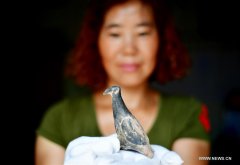Across China: Modernity puts traditional shadow puppets in the shade
CHENGDU, April 24 (Xinhua) -- Two warriors in ancient costume fight ferociously. Suddenly, to the dramatic sound of drums a red-faced warrior pulls out his sword before beheading his white-faced enemy.
This is not a scene from a film, but a traditional Chinese shadow puppet performance, where colored silhouette figures made from cow hide show how Guan Yu, a prominent ancient general, fought during his many battles.
Behind the curtain is the soul of the performance -- puppeteer Wang Biao. Using his flexible hands, and voice, he makes the small figures stroke their beards, nod their heads, wave their hands and curse others.
"This performing art has run in my family for seven generations," said Wang, 52, from Langzhong city in southwest China's Sichuan Province.
Despite its long history, shadow puppetry is under threat from modern entertainment alternatives such as television and cinema.
Wang is trying to bring people's attention back to the traditional art. With the support of a national fund, he is currently teaching 20 students from across the country to learn the skills needed to master the puppets.
"I hope that such folk culture will survive the threat of modernity and thrive in the future," he said.
OUT OF THE SHADOWS
Shadow puppetry has a long history. Ancient Chinese historical records show that shadow plays were originally created by a Chinese Taoist during the Han Dynasty (202 B.C. to 220 A.D.) to console the heartbroken Emperor Wu, who had lost one of his imperial concubines. The Taoist made a stone image of the concubine and put it in a tent by a burning candle. The shadow cast looked like his loved one and helped his sadness faded away.
Over the next two thousand years, the stone figures gradually became cowhide ones, and the tents were turned into curtains. Performers then added drum sounds and Chinese opera to the movement of the figures, and the shadow play was born.
Wang Biao watched a shadow performance when he graduated from junior school.
"I thought it was humorous and eye-catching, and the figures were quite colorful," he said.
Wang's grandfather, a renowned shadow puppet performer in northern Sichuan, would take Wang along during his performances.
"He even paid a professional shadow performer to teach me," Wang said.
However, learning is very difficult and it can take years before puppeteers are ready to go on stage.
"Every movement has to be on point," Wang said. "You need to memorize the whole script, and sing the lines of all kinds of characters, while showing their emotions with the puppet strings."
Shadow plays went through a hiatus during the tumult of the Cultural Revolution between 1966 and 1976, but reemerged shortly after in the early 1980s, when the art was involved in rural marriage ceremonies, funerals and banquets.
Since the reform and opening-up, however, a large number of rural residents moved to the cities for better jobs, while domestic appliances like TV sets and radios became popular. The art began to lose younger audiences and had to compete with modern entertainment.
Wang gave up puppetry in 1991 and went to the southern metropolis of Shenzhen to work on a pig farm. He soon made lots of money, but could not forget his puppet plays.
"I told myself that I could not let the art disappear in my hands," Wang said.
In 2000, he went back to Sichuan and, with the help of a friend, managed to put on a show in the provincial capital, Chengdu. The performance was a huge success and generated lots of media buzz.
Four years later, Wang went back to his hometown and started a shadow play troupe. Meanwhile, he continued to look for people willing to learn the art.
In 2007, he recruited 22 students to learn the art from him. He broke the tradition of imparting the skill to male students, by recruiting both male and female students, giving each of them 600 yuan (87 U.S. dollars) in subsidies every month.
But his efforts went to no avail. Most of the students looked at the art as "a temporary job" and gradually left. The last one to leave Wang's troupe was his favorite, but he told Wang that he was going to join the army.
"I gave him 1,000 yuan and bought him some fruit before sending him on his way," Wang said. "After that, I closed all the doors and cried."
Wang then locked himself in his room for the entire day, believing his craft was dying out for good.
Later Wang told his story to an official from the Ministry of Culture, and the official complimented him for "doing a worthy thing."
"Related laws and regulations protecting the art are still under discussion," the official told Wang.
In June 2011, China issued a law protecting intangible cultural heritage. In the same year, shadow puppetry was put on a list of intangible cultural heritage by UNESCO.
"Since then, I have felt like I will no longer be alone in the protection of cultural heritage," Wang said.
In the past few years, the limit of the fund Wang can apply for rose from 300,000 yuan to 1.5 million yuan, and he also receives 20,000 yuan of subsidies each year from the government.
A 4,200-square-meter museum featuring shadow puppetry is now under construction on a main street in his hometown. It will display the 50,000 puppets Wang owns.
Wang hopes to train more talent and create more shadow performing programs.
"I'm just glad that shadow plays are crawling out of the shadows in the modern era," he said.















